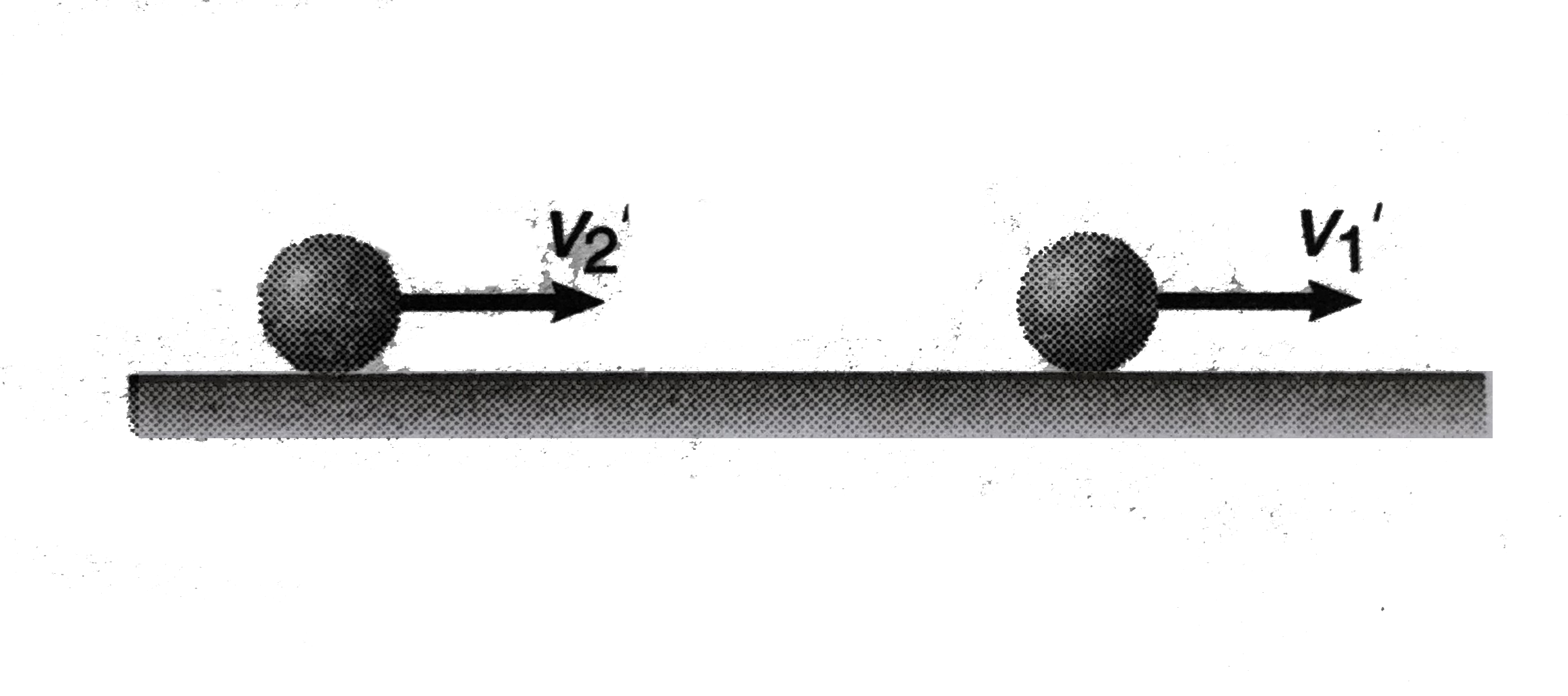A ball of mass 4 kg moving on a smooth horizontal surface makes an elastic collision with another ball of mass m at rest in the line of motion of first ball. If after collision first ball moves in the same direction with one fourth of its velocity before collision, then mass of second ball is
4 kg
4.4 kg
2.4 kg
2 kg
The correct Answer is:C
To solve the problem step by step, we will use the principles of conservation of momentum and the characteristics of elastic collisions.
Step 1: Understand the Problem
We have two balls:
- Ball 1 (mass m1=4kg) is moving with an initial velocity V.
- Ball 2 (mass m2=m) is at rest.
After the collision, Ball 1 moves with a velocity of V4.
Step 2: Use the Conservation of Momentum
The law of conservation of momentum states that the total momentum before the collision is equal to the total momentum after the collision.
Before the collision:
- Momentum of Ball 1 = 4V
- Momentum of Ball 2 = 0
Total initial momentum:
Pinitial=4V+0=4V
After the collision:
- Momentum of Ball 1 = 4×V4=V
- Momentum of Ball 2 = m⋅u (where u is the final velocity of Ball 2)
Total final momentum:
Pfinal=V+mu
Setting the initial momentum equal to the final momentum:
4V=V+mu
Step 3: Solve for mu
Rearranging the equation gives:
4V−V=mu⟹3V=mu
u=3Vm
Step 4: Use the Elastic Collision Condition
In an elastic collision, the coefficient of restitution e is defined as:
e=velocity of separationvelocity of approach=1
Velocity of separation:
- For Ball 1: V4
- For Ball 2: u
The velocity of separation is:
u−V4
Velocity of approach:
- For Ball 1: V
- For Ball 2: 0
The velocity of approach is:
V−0=V
Setting the coefficient of restitution to 1:
1=u−V4V
Step 5: Solve for u
Rearranging gives:
u−V4=V
u=V+V4=5V4
Step 6: Substitute u into the Momentum Equation
Now, substitute u back into the momentum equation:
3V=m⋅5V4
Step 7: Solve for m
Cancelling V (assuming V≠0):
3=m⋅54
m=3⋅45=125=2.4kg
Conclusion
The mass of the second ball is 2.4kg.
---
We have two balls:
- Ball 1 (mass m1=4kg) is moving with an initial velocity V.
- Ball 2 (mass m2=m) is at rest.
The law of conservation of momentum states that the total momentum before the collision is equal to the total momentum after the collision.
- Momentum of Ball 1 = 4V
- Momentum of Ball 2 = 0
Pinitial=4V+0=4V
- Momentum of Ball 1 = 4×V4=V
- Momentum of Ball 2 = m⋅u (where u is the final velocity of Ball 2)
Pfinal=V+mu
4V=V+mu
Rearranging the equation gives:
4V−V=mu⟹3V=mu
u=3Vm
In an elastic collision, the coefficient of restitution e is defined as:
e=velocity of separationvelocity of approach=1
- For Ball 1: V4
- For Ball 2: u
u−V4
- For Ball 1: V
- For Ball 2: 0
V−0=V
1=u−V4V
Rearranging gives:
u−V4=V
u=V+V4=5V4
Now, substitute u back into the momentum equation:
3V=m⋅5V4
Cancelling V (assuming V≠0):
3=m⋅54
m=3⋅45=125=2.4kg
The mass of the second ball is 2.4kg.
Topper's Solved these Questions
- WORK, ENERGY AND POWERBOOK - AAKASH INSTITUTECHAPTER - WORK, ENERGY AND POWEREXERCISE - Assignment (SECTION - A)
67 Videos
- WORK, ENERGY AND POWERBOOK - AAKASH INSTITUTECHAPTER - WORK, ENERGY AND POWEREXERCISE - Assignment (SECTION - B)
39 Videos
- WORK, ENERGY AND POWERBOOK - AAKASH INSTITUTECHAPTER - WORK, ENERGY AND POWEREXERCISE - SECTION-J (AAKASH CHALLENGERS QUESTIONS)
14 Videos
- WAVESBOOK - AAKASH INSTITUTECHAPTER - WAVESEXERCISE - ASSIGNMENT ( SECTION-D ( Assertion - Reason Type Questions ))
12 Videos
Similar Questions
A ball of mass m moving at a speed v makes a head on inelastic collision with an identical ball at rest. The kinetic energy of the balls after the collision is 34th of the original. Find the coefficient of restitution.


View SolutionA ball of mass 1kg moving with a velocity of 15m/s undergoes a head on elastic collision with another ball of unknown mass at rest, and rebound with a velocity of 10m/s. What is the mass of the other ball?
View Solution
Knowledge Check
A ball of mass M moving with speed v collides perfectly inelastically with another ball of mass m at rest. The magnitude of impulse imparted to the first ball is
AMvBmvCMmM+mvDM2M+mvA ball P of mass 2kg undergoes an elastic collision with another ball Q at rest. After collision, ball P continues to move in its original direction with a speed one-fourth of its original speed. What is the mass of ball Q ?
A0.9 kgB1.2 kgC1.5 kgD1.8 kgA ball of mass 5 kg travelling with velocity of 15 cm/s makes a head on collision with another ball of mass 1 kg which is at rest. After the collision, the speed of the lighter ball is
Azero.Bless than 15 cm/s.Cequal to 15 cm/s.Dgreater than 15 cm/s.
A ball of mass m makes an elastic collision with another identical ball at rest. Show that if the collision is oblique, the bodies go at right angles to each other after collision.
View SolutionA ball of mass M moving with a velocity v collides perfectly inelastically with another ball of same mass but moving with a velocity v in the opposite direction. After collision
View SolutionA ball of 4kg mass moving with a speed of 3ms−1 has a head on elastic collision with a 6kg mass initially at rest. The speeds of both the bodies after collision are respectively
View SolutionA ball of mass m moving with a velocity v undergoes an oblique elastic collision with another ball of the same mass m but at rest. After the collision if the two balls move with the same speeds , the angle between their directions of motion will be:
View SolutionA ball of mass 'm' moving with speed 'u' undergoes a head-on elastic collision with a ball of mass 'nm' initially at rest. Find the fraction of the incident energy transferred to the second ball.
View Solution
